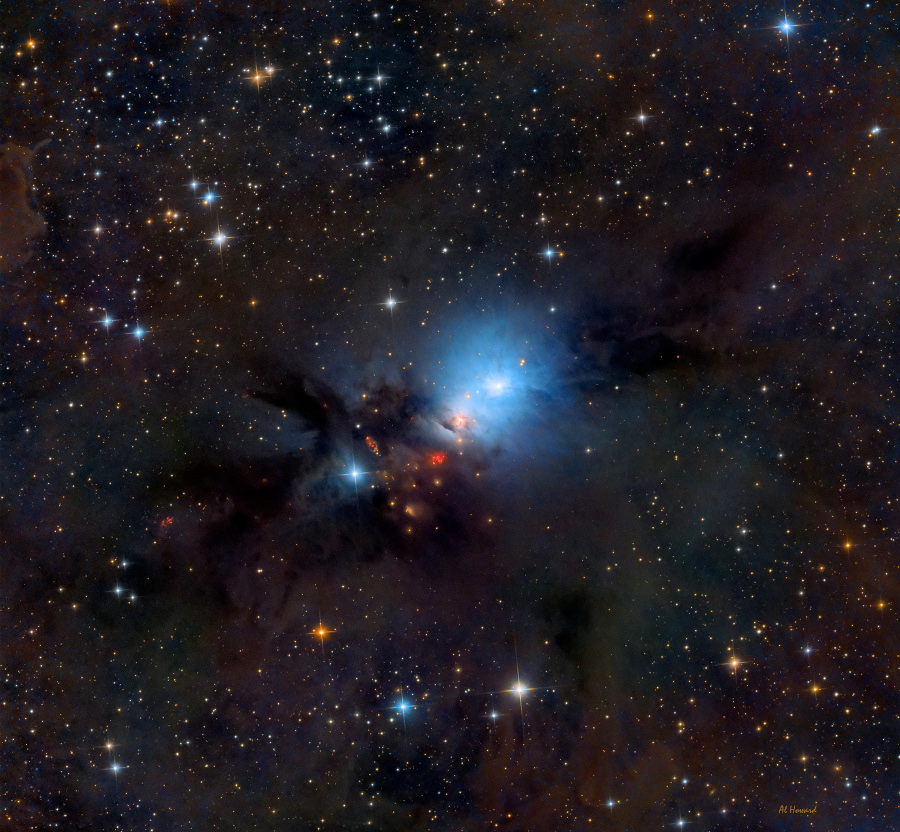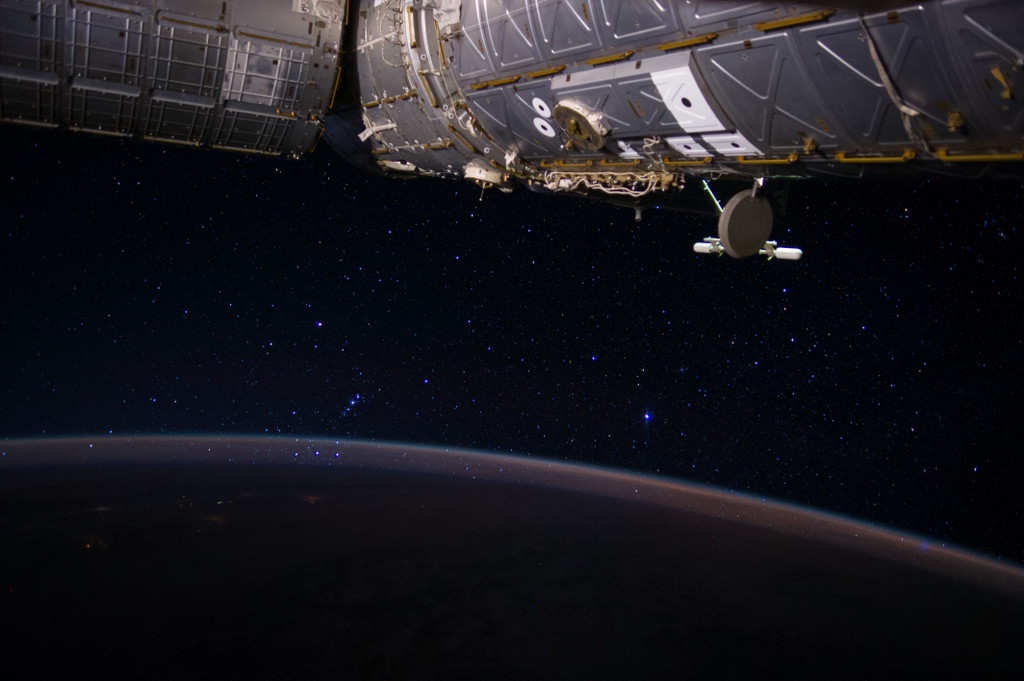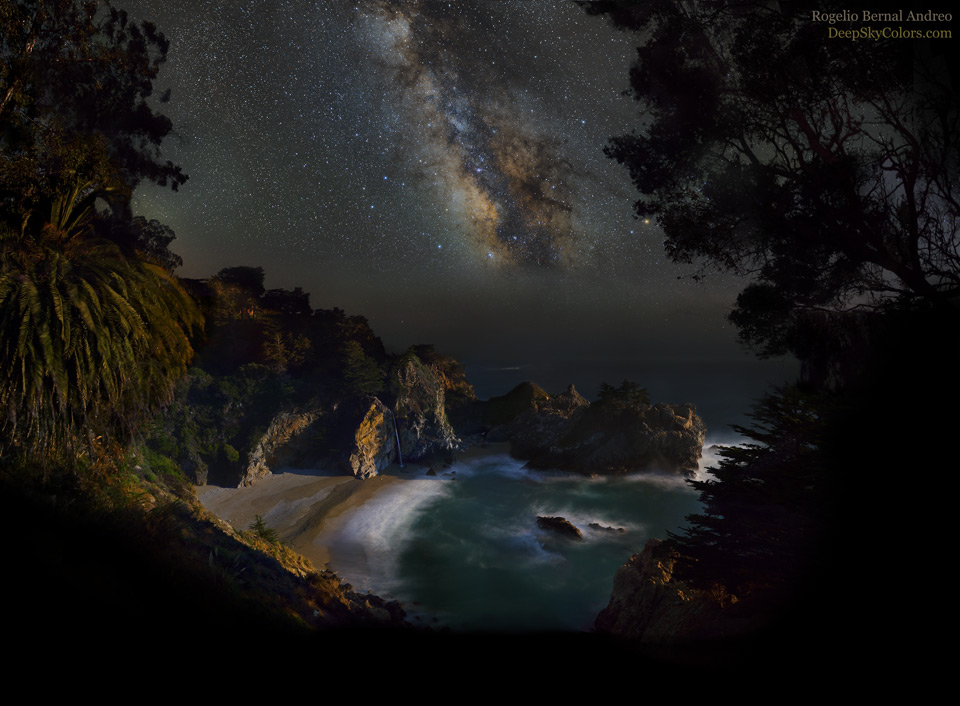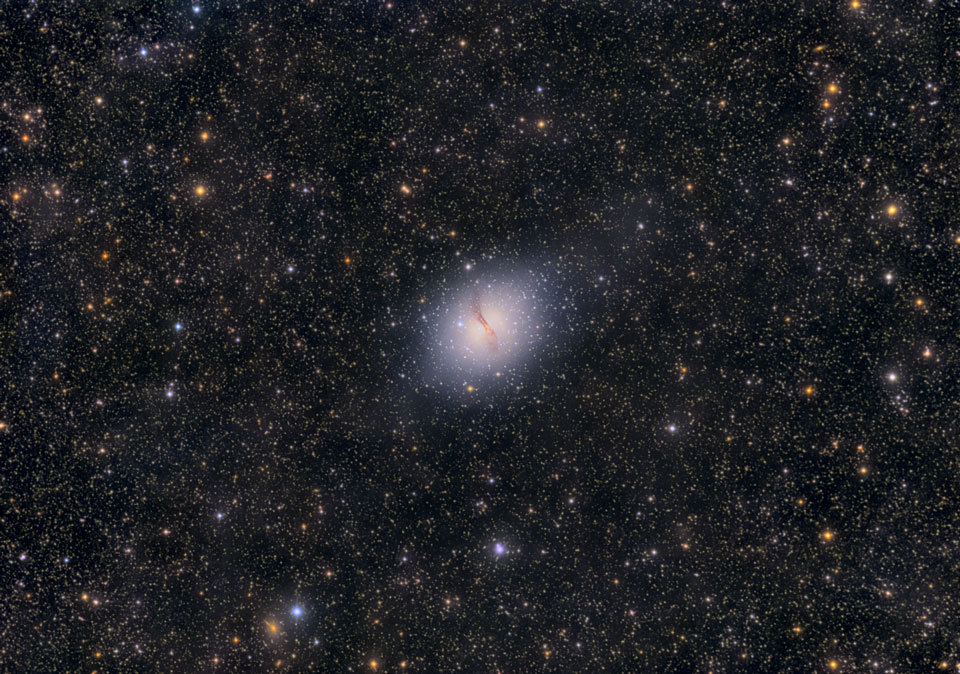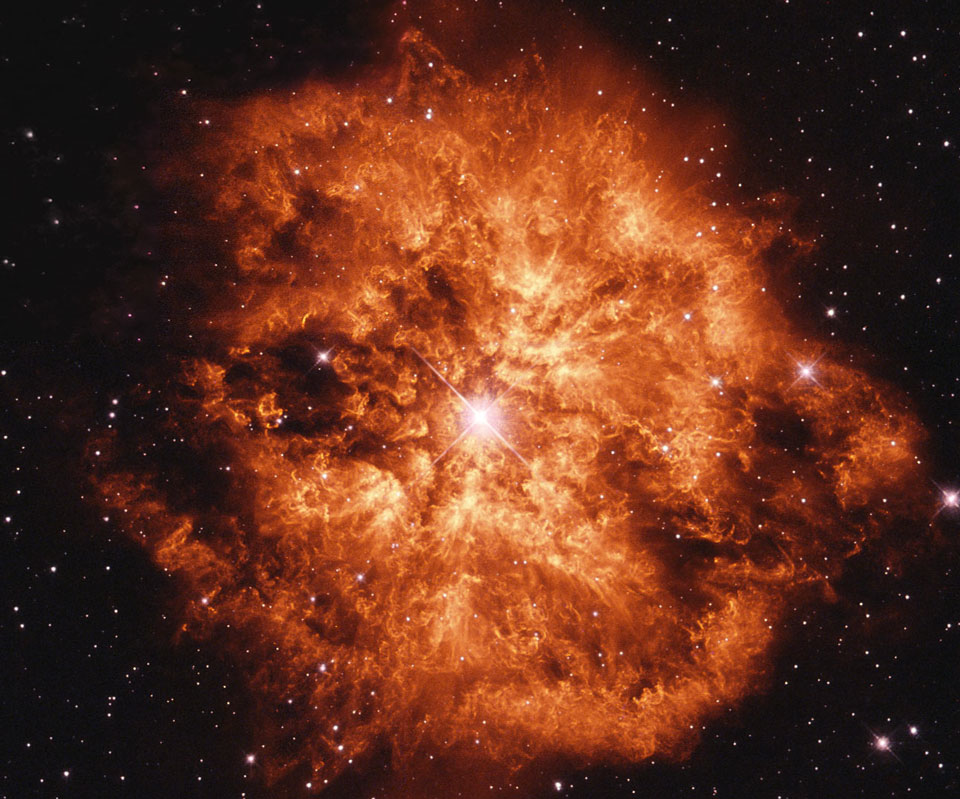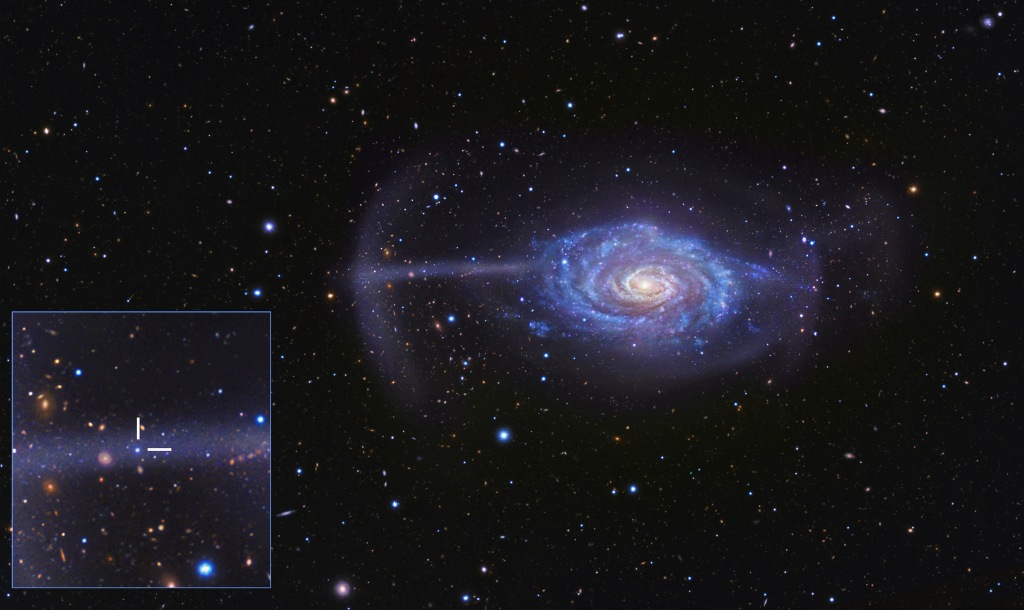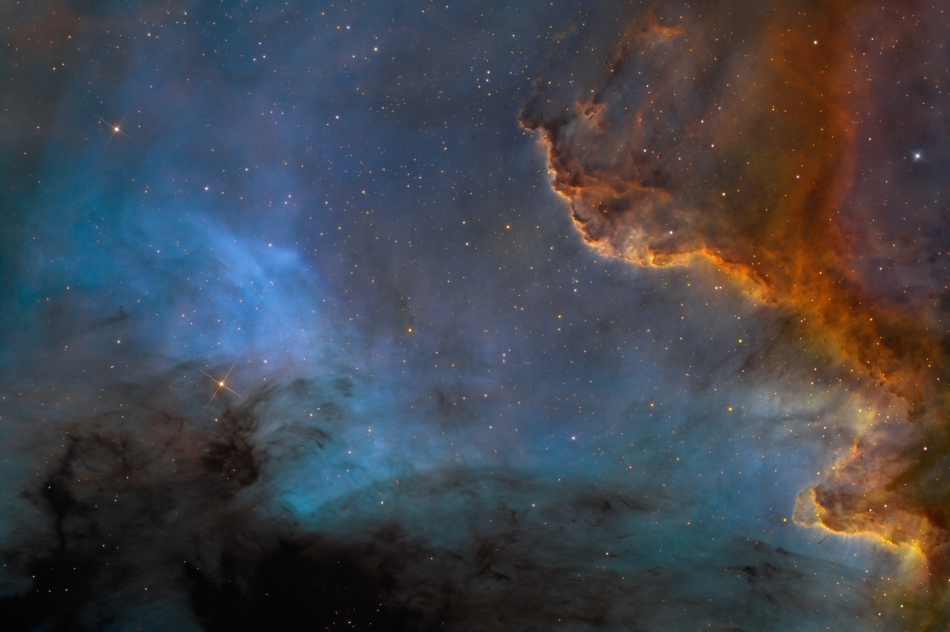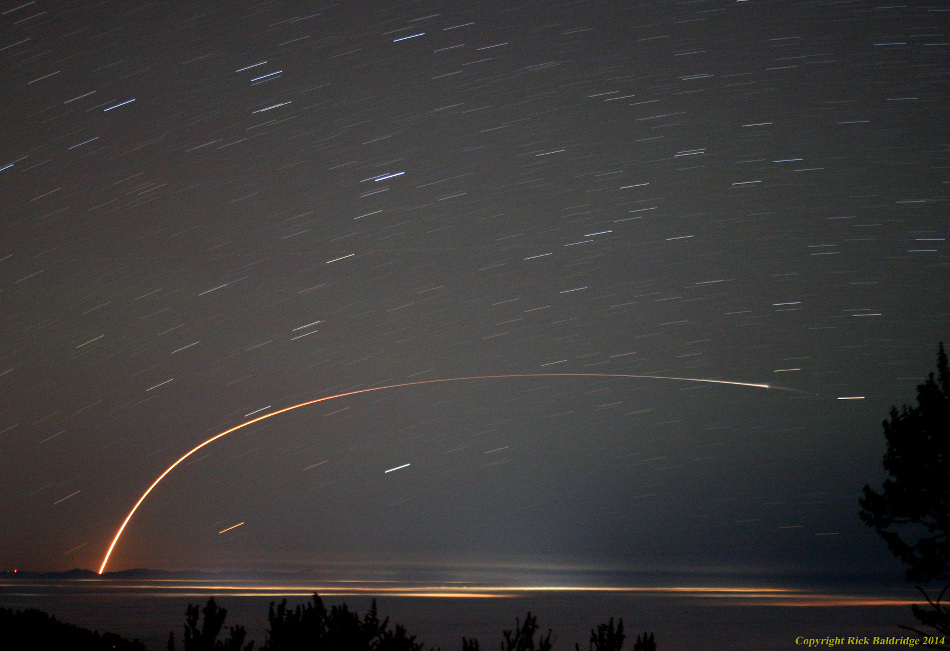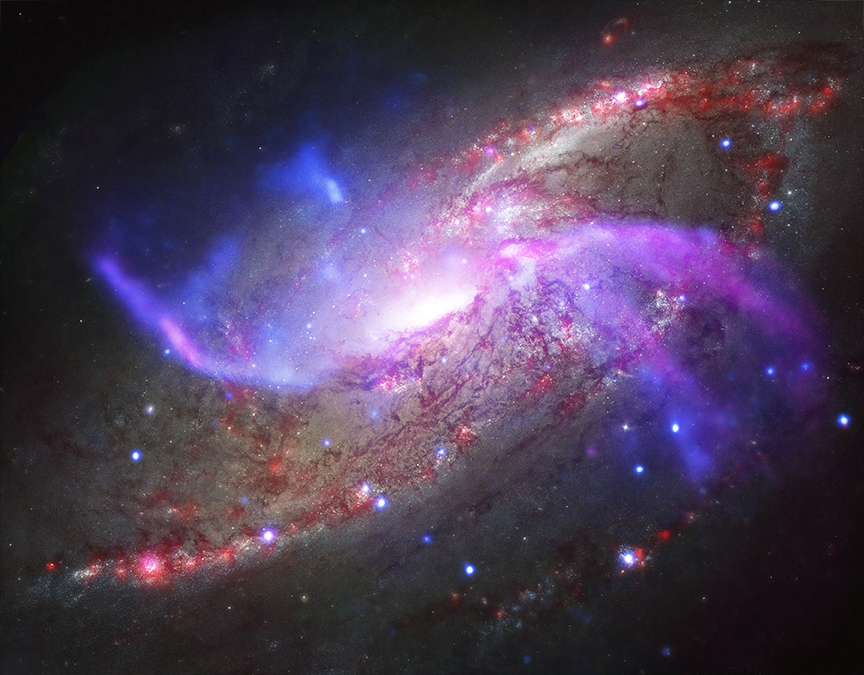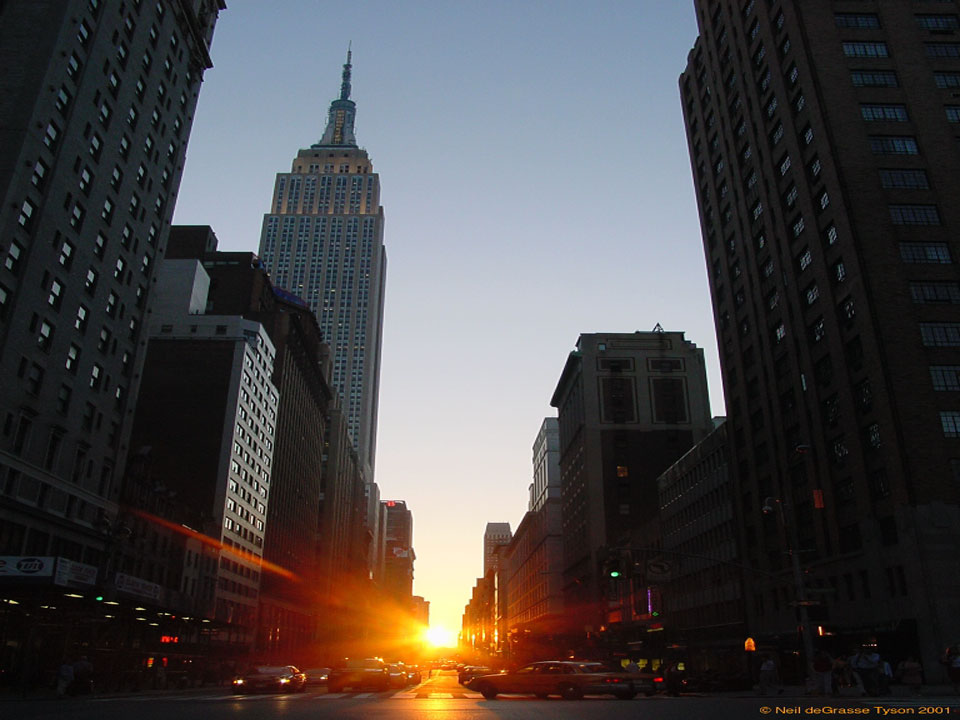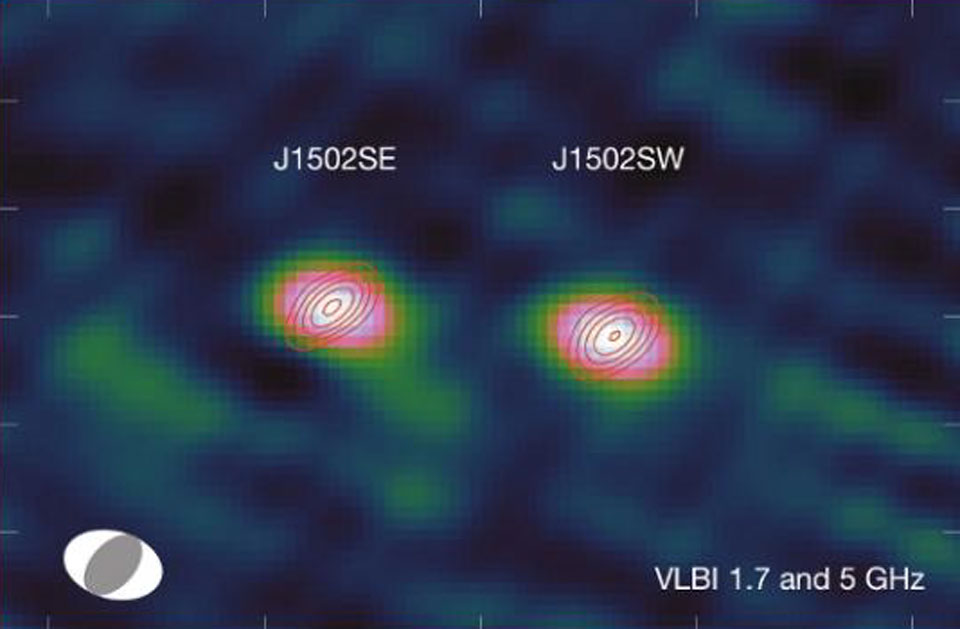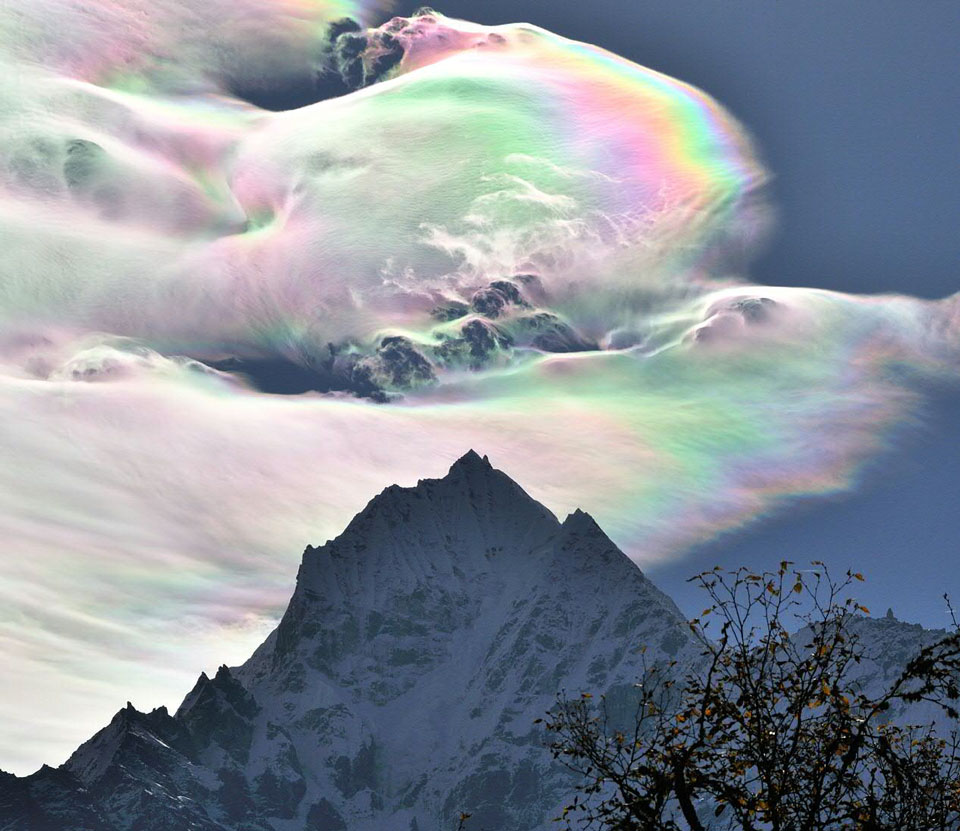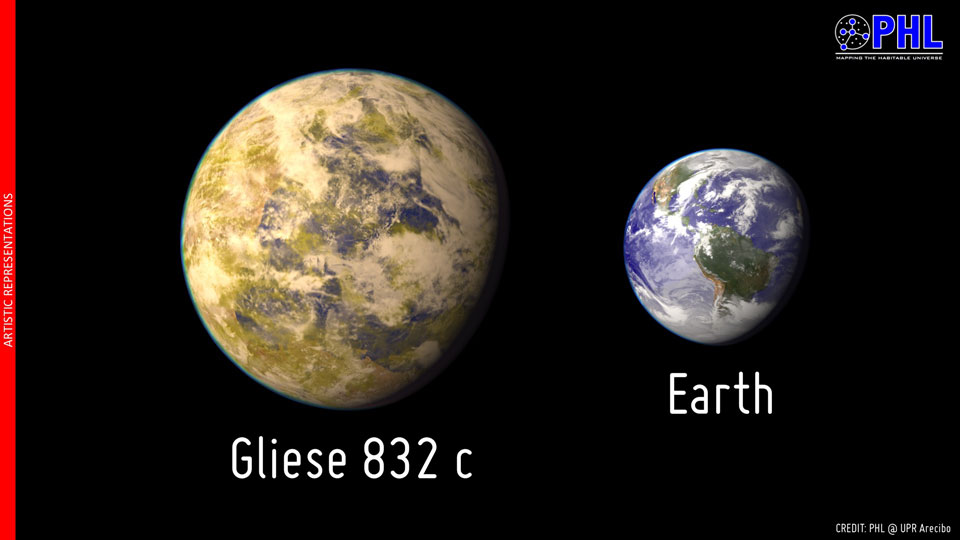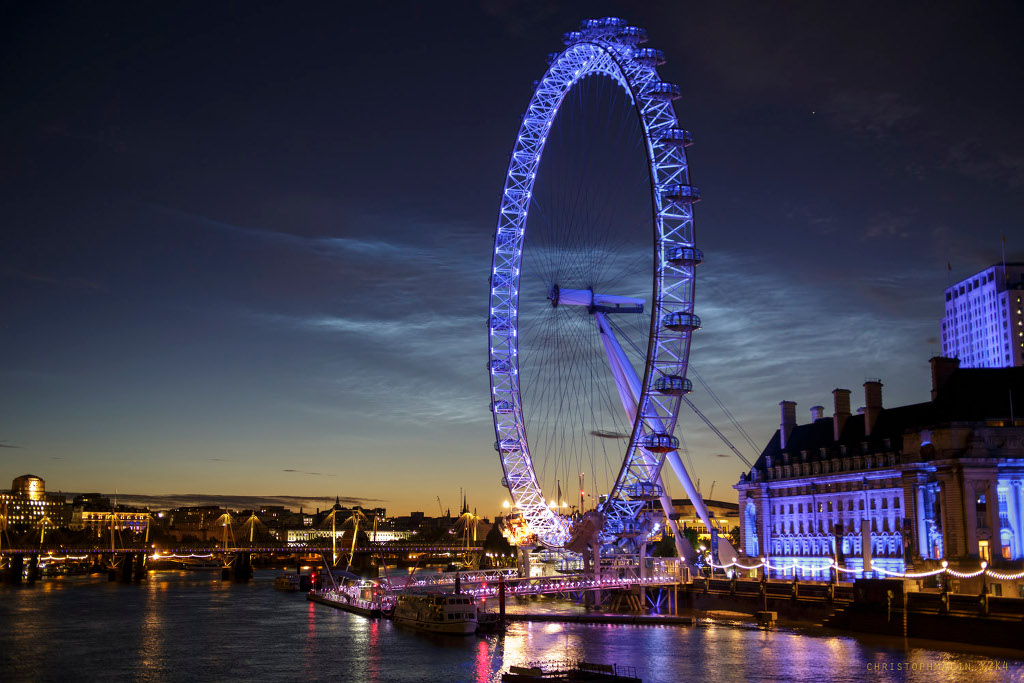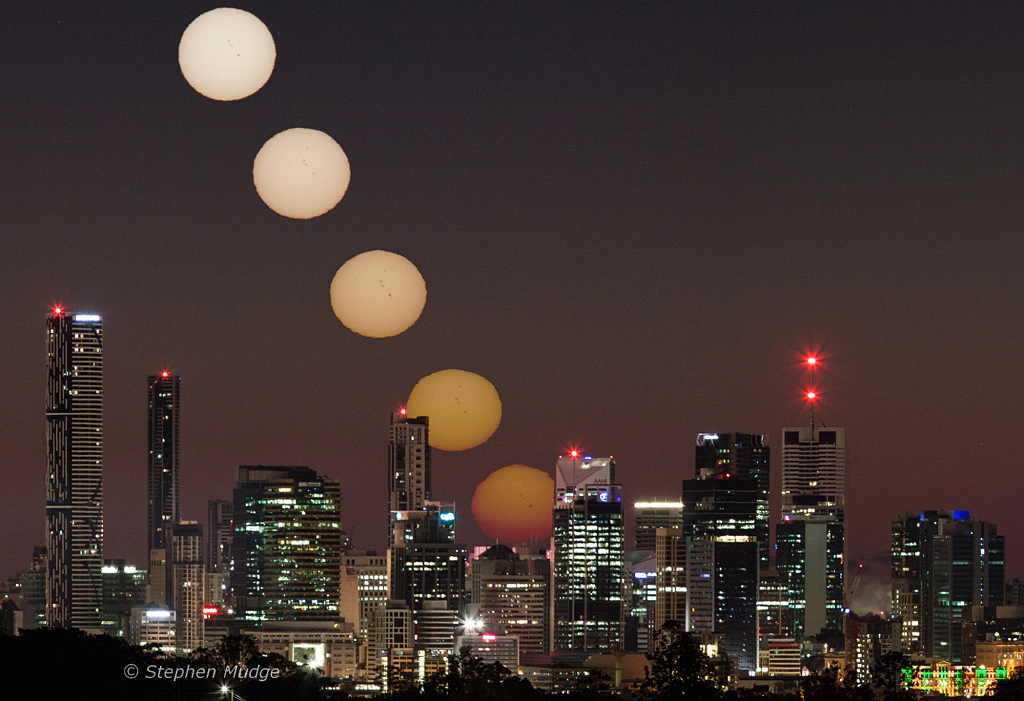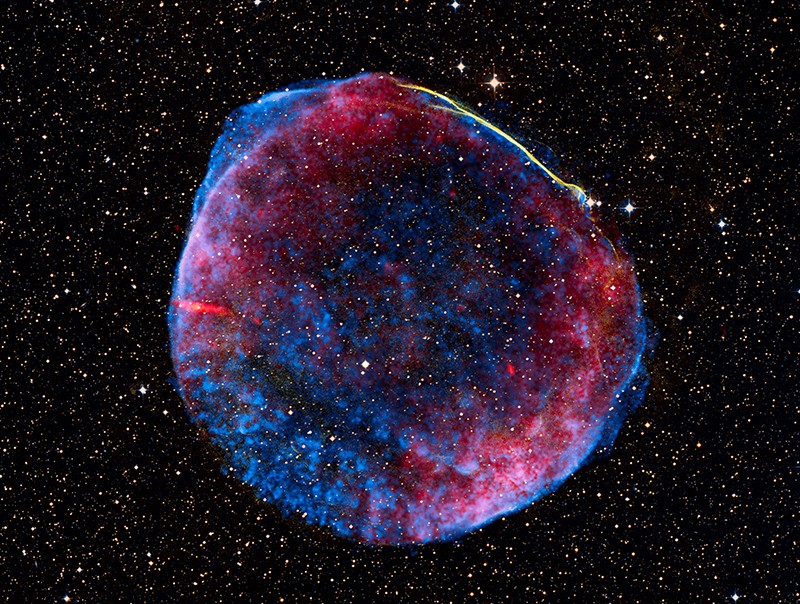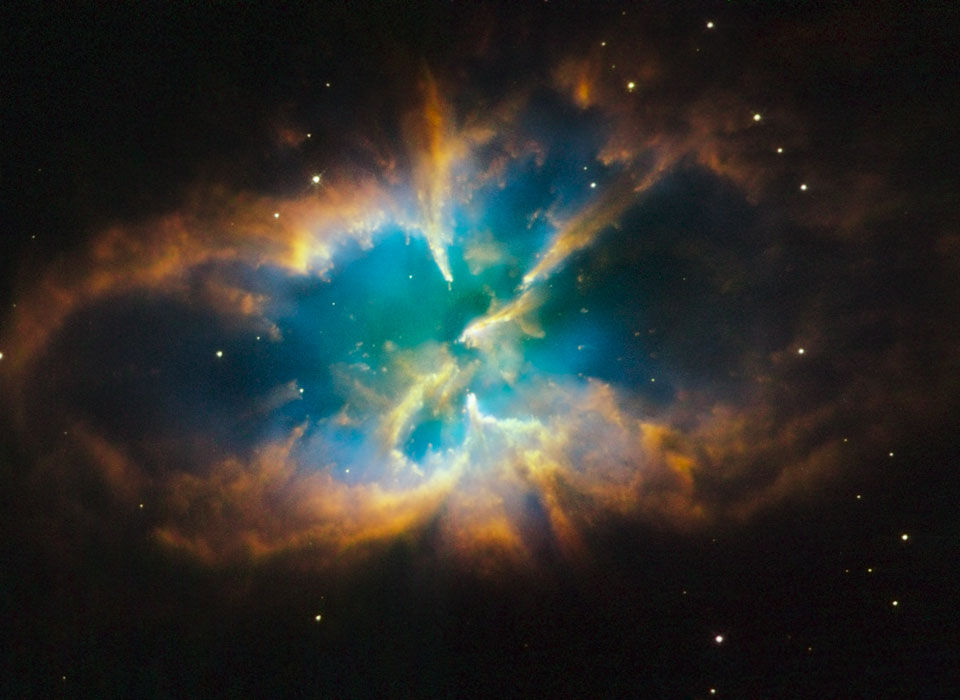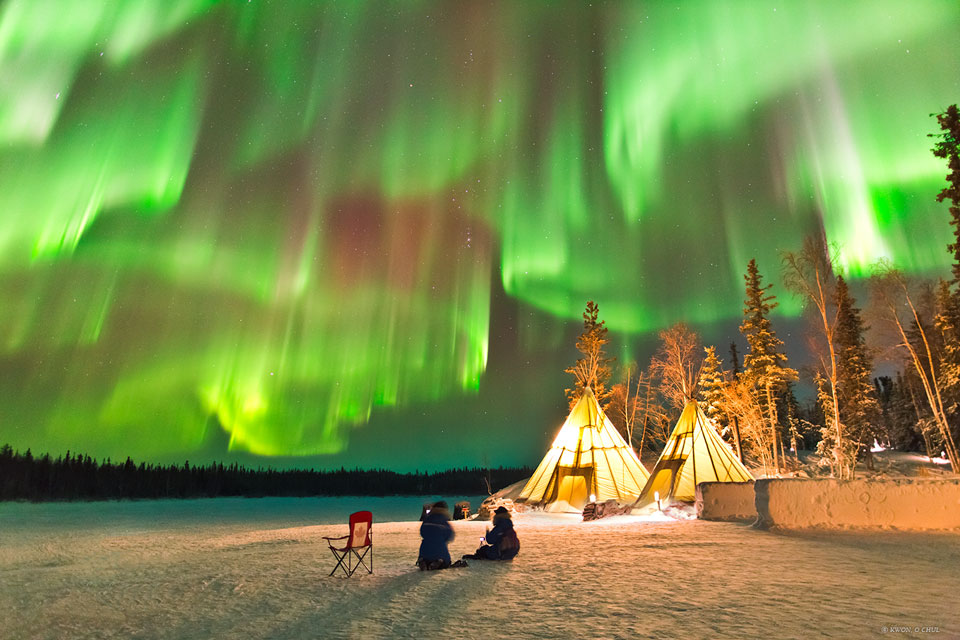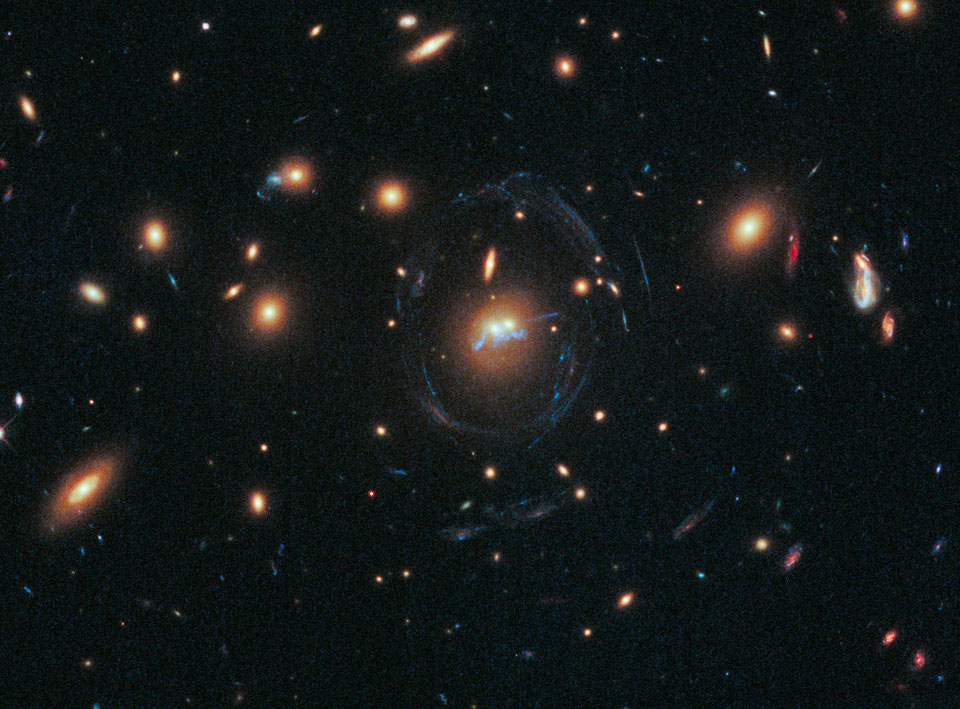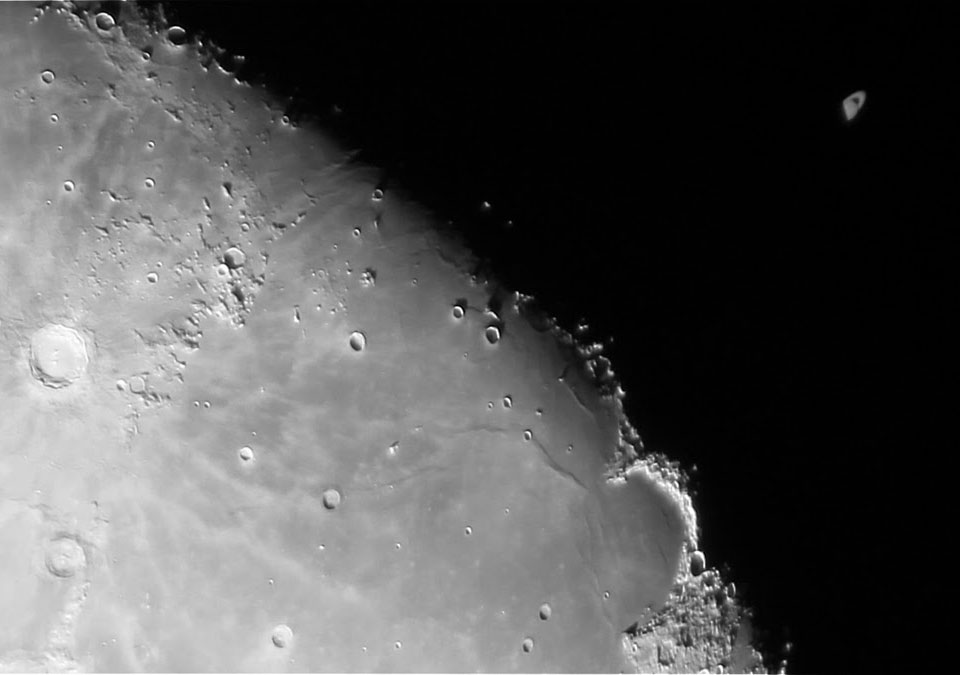
|
| Title: Astronomy Picture of the Day | |
| friendsoffortiesfive > General > General Discussion | Go to subcategory: |
| Author | Content |
|
Niceguy2
|
|
|
Date Posted:03/06/2014 11:29 PMCopy HTML I really love this site and |
|
|
Niceguy2
|
#176 |
|
Re:Astronomy Picture of the Day Date Posted:06/28/2014 9:27 PMCopy HTML Image Credit: NASA, ISS Expedition 40, Reid Wiseman Explanation: Orion's belt runs just along the horizon, seen through Earth's atmosphere and rising in this starry snapshot from low Earth orbit on board the International Space Station. The belt stars, Alnitak, Alnilam, and Mintaka run right to left and Orion's sword, home to the great Orion Nebula, hangs above his belt, an orientation unfamiliar to denizens of the planet's northern hemisphere. That puts bright star Rigel, at the foot of Orion, still higher above Orion's belt. Of course the brightest celestial beacon in the frame is Sirius, alpha star of the constellation Canis Major. The station's Destiny Laboratory module is in the foreground at the top right. |
|
|
Niceguy2
|
#177 |
|
Re:Astronomy Picture of the Day Date Posted:06/29/2014 10:53 PMCopy HTML Image Credit & Copyright: Rogelio Bernal Andreo (Deep Sky Colors) Explanation: To see a vista like this takes patience, hiking, and a camera. Patience was needed in searching out just the right place and waiting for just the right time. A short hike was needed to reach thisrugged perch above a secluded cove in Julia Pfeiffer Burns State Park in California, USA. And a camera was needed for the long exposure required to bring out the faint light from stars and nebulae in the background Milky Way galaxy. Moonlight illuminated the hidden beach and inlet behind nearby trees in the above composite image taken last month. Usually obscured McWay Falls is visible just below the image center, while the Pacific Ocean is in view to its right. The above image is a high-resolution sequel to a similar image that appeared last year. |
|
|
ravch641943
|
#178 |
|
Re:Astronomy Picture of the Day Date Posted:06/29/2014 11:20 PMCopy HTML Some fantastic pictures.
|
|
|
Niceguy2
|
#179 |
|
Re:Astronomy Picture of the Day Date Posted:06/30/2014 9:40 PMCopy HTML Image Credit & Copyright: Roberto Colombari Explanation: What's happened to the center of this galaxy? Unusual and dramatic dust lanes run across the center of elliptical galaxy Centaurus A. These dust lanes are so thick they almost completely obscure the galaxy's center in visible light. This is particularly unusual as Cen A's red stars and round shape are characteristic of a giant elliptical galaxy, a galaxy type usually low in dark dust. Cen A, also known as NGC 5128, is also unusual compared to an average elliptical galaxy because it contains a higher proportion of young blue stars and is a very strong source of radio emission. Evidence indicates thatCen A is likely the result of the collision of two normal galaxies. During the collision, many young stars were formed, but details of the creation of Cen A's unusual dust belts are still being researched. Cen Alies only 13 million light years away, making it the closest active galaxy. Cen A, pictured above, spans 60,000 light years and can be seen with binoculars toward the constellation of Centaurus. |
|
|
Niceguy2
|
#180 |
|
Re:Astronomy Picture of the Day Date Posted:07/02/2014 1:09 AMCopy HTML Image Credit: Hubble Legacy Archive, NASA, ESA - Processing & Licence: Judy Schmidt Explanation: Some stars explode in slow motion. Rare, massive Wolf-Rayet stars are so tumultuous and hot that they slowly disintegrating right before our telescopes. Glowing gas globs each typically over 30 times more massive than the Earth are being expelled by violent stellar winds. Wolf-Rayet star WR 124, visible near the above image center spanning six light years across, is thus creating the surrounding nebula known as M1-67. Details of why this star has been slowly blowing itself apart over the past 20,000 years remains a topic of research. WR 124 lies 15,000 light-years away towards the constellation ofSagitta. The fate of any given Wolf-Rayet star likely depends on how massive it is, but many are thought to end their lives with spectacular explosions such as supernovas or gamma-ray bursts. |
|
|
Niceguy2
|
#181 |
|
Re:Astronomy Picture of the Day Date Posted:07/02/2014 9:22 PMCopy HTML Image Credit & Copyright: R Jay Gabany (Blackbird Observatories) Collaboration: C.Foster (Australian Astronomical Obs.), H.Lux (U. Nottingham, Oxford), A.Romanowsky (San Jose State, UCO), D.Martínez-Delgado (Heidelberg), et al. Explanation: Spiral galaxy NGC 4651 is a mere 62 million light-years distant, toward the well-groomed northern constellation Coma Berenices. About the size of our Milky Way, this island universe is seen to have a faint umbrella-shaped structure that seems to extend (left) some 100 thousand light-years beyond the bright galactic disk. The giant cosmic umbrella is now known to be composed of tidal star streams - extensive trails of stars gravitationally stripped from a smaller satellite galaxy. The small galaxy was eventually torn apart in repeated encounters as it swept back and forth on eccentric orbits through NGC 4651. In fact, the picture insert zooms in on the smaller galaxy's remnant core, identified in an extensive exploration of the system, using data from the large Subaru and Keck telescopes on Mauna Kea. Work begun by a remarkable collaboration of amateur and professional astronomers to image faint structures around bright galaxies suggests that even in nearby galaxies, tidal star streams are common markers of such galactic mergers. The result is explained by models of galaxy formation that also apply to our own Milky Way. |
|
|
Niceguy2
|
#182 |
|
Re:Astronomy Picture of the Day Date Posted:07/03/2014 11:34 PMCopy HTML Image Credit & Copyright: Martin Pugh Explanation: The prominent ridge of emission featured in this vivid skyscape is known as the Cygnus Wall. Part of a larger emission nebula with a distinctive shape popularly called The North America Nebula, the ridge spans about 10 light-years along an outline that suggests the western coast of Mexico. Constructed from narrowband image data, the cosmic close-up maps emission from sulfur, hydrogen, and oxygen atoms to red, green, and blue colors. The result highlights the bright ionization front with fine details of dark, dusty forms in silhouette. Sculpted by energetic radiation from the region's young, hot, massive stars, the dark shapes inhabiting the view are clouds of cool gas and dust with stars likely forming within. The North America Nebula itself, NGC 7000, is about 1,500 light-years away. To find it, look northeast of bright star Deneb in the high flying constellation Cygnus. |
|
|
Niceguy2
|
#183 |
|
Re:Astronomy Picture of the Day Date Posted:07/05/2014 6:35 AMCopy HTML Image Credit & Copyright: Rick Baldridge Explanation: In this alluring time exposure, star trails arc across the night sky above foggy Monterey Bay and the lights of Santa Cruz, California in the United States of America. Since the exposure began around 2:56am PDT on July 2 it also records the trail of a Delta II rocket lofting NASA's OCO-2 spacecraft into orbit. Seen from a vantage point 200 miles north of the Vandenberg Air Force Base launch site, the trail represents the first five minutes of the rocket's flight along a trajectory south and west over the Pacific to join the A-Train in polar orbit around planet Earth. The entire trail through main engine cut-off is captured, with a very faint puff at the end marking the nose fairing separation. Under the rocket's path, the two brightest trails are the alpha and beta stars of the constellation Grus, flying high in southern skies. The OCO-2 mission goal is a study of atmospheric carbon dioxide, watching from space as planet Earth breathes. |
|
|
Niceguy2
|
#184 |
|
Re:Astronomy Picture of the Day Date Posted:07/05/2014 6:39 AMCopy HTML Image Credit: X-ray - NASA / CXC / Caltech / P.Ogle et al., Optical - NASA/STScI, IR - NASA/JPL-Caltech, Radio - NSF/NRAO/VLA Explanation: The spiral arms of bright, active galaxy M106 sprawl through this remarkable multiwavelength portrait, composed of image data from radio to X-rays, across the electromagnetic spectrum. Also known as NGC 4258, M106 can be found toward the northern constellation Canes Venatici. The well-measured distance to M106 is 23.5 million light-years, making this cosmic scene about 60,000 light-years across. Typical in grand spiral galaxies, dark dust lanes, youthful star clusters, and star forming regions trace spiral arms that converge on a bright nucleus. But this composite highlights two anomalous arms in radio (purple) and X-ray (blue) that seem to arise in the central region of M106, evidence of energetic jets of material blasting into the galaxy's disk. The jets are likely powered by matter falling into amassive central black hole. |
|
|
Niceguy2
|
#185 |
|
Re:Astronomy Picture of the Day Date Posted:07/06/2014 8:32 PMCopy HTML Image Credit & Copyright: Neil deGrasse Tyson (AMNH) Explanation: This coming Saturday, if it is clear, well placed New Yorkers can go outside at sunset and watch their city act like a modern version of Stonehenge. Manhattan's streets will flood dramatically with sunlight just as the Sun sets precisely at each street's western end. Usually, the tall buildings that line the gridded streets of New York City's tallest borough will hide the setting Sun. This effect makesManhattan a type of modern Stonehenge, although only aligned to about 30 degrees east of north. Were Manhattan's road grid perfectly aligned to east and west, today's effect would occur on the Vernal andAutumnal Equinox, March 21 and September 21, the only two days that the Sun rises and sets due east and west. Pictured above in this horizontally stretched image, the Sun sets down 34th Street as viewed from Park Avenue. If Saturday's sunset is hidden by clouds do not despair -- the same thing happens twice each year: in late May and mid July. On none of these occasions, however, should you ever look directly at the Sun. |
|
|
Niceguy2
|
#186 |
|
Re:Astronomy Picture of the Day Date Posted:07/07/2014 9:18 PMCopy HTML Image Credit: R. P. Deane (U. Capetown) et al. Explanation: Most galaxies contain one supermassive black hole -- why does this galaxy have three? The likely reason is that galaxy J1502+1115 is the product of the recent coalescence of three smaller galaxies. The two closest black holes are shown above resolved in radio waves by large coordinated array of antennas spread out over Europe, Asia, and Africa. These two supermassive black holes imaged are separated by about 500 light years and each has a likely mass about 100 million times the mass of our Sun. Currently, J1502+1115, at a redshift of 0.39, is one of only a few triple black hole system known and is being studied to learn more about galaxy and supermassive black hole interaction rates during the middle ages of our universe. Gravitational radiation emitted by such massive black hole systems may be detectable by future observatories. |
|
|
Niceguy2
|
#187 |
|
Re:Astronomy Picture of the Day Date Posted:07/08/2014 9:19 PMCopy HTML Image Credit & Copyright: Oleg Bartunov Explanation: Why would a cloud appear to be different colors? A relatively rare phenomenon known as iridescent clouds can show unusual colors vividly or a whole spectrum of colors simultaneously. Theseclouds are formed of small water droplets of nearly uniform size. When the Sun is in the right position and mostly hidden by thick clouds, these thinner clouds significantly diffract sunlight in a nearly coherent manner, with different colors being deflected by different amounts. Therefore, different colors will come to the observer from slightly different directions. Many clouds start with uniform regions that could showiridescence but quickly become too thick, too mixed, or too far from the Sun to exhibit striking colors. The above iridescent cloud was photographed in 2009 from the Himalayan Mountains in Nepal, behind the 6,600-meter peak named Thamserku. |
|
|
Niceguy2
|
#188 |
|
Re:Astronomy Picture of the Day Date Posted:07/09/2014 11:44 PMCopy HTML Image Credit & Copyright: The Planetary Habitability Laboratory @ UPR Arecibo; Discovery: Robert A. Wittenmyer (UNSW Australia) et al. Explanation: This planet is only 16 light years away -- could it harbor life? Recently discovered exoplanet Gliese 832c has been found in a close orbit around a star that is less bright than our Sun. An interesting coincidence, however, is that Gliese 832c receives just about the same average flux from its parent star as does the Earth. Since the planet was discovered only by a slight wobble in its parent star's motion, the above illustration is just an artistic guess of the planet's appearance -- much remains unknown about Gliese 832c's true mass, size, and atmosphere. If Gliese 832c has an atmosphere like Earth, it may be a super-Earth undergoing strong seasons but capable of supporting life. Alternatively, if Gliese 832c has a thick atmosphere like Venus, it may be a super-Venus and so unlikely to support life as we know it. The close 16-light year distance makes the Gliese 832 planetary system currently the nearest to Earth that could potentially support life. The proximity of the Gliese 832 system therefore lends itself to more detailed future examination and, in the most spectacularly optimistic scenario, actual communication -- were intelligent life found there. |
|
|
Niceguy2
|
#189 |
|
Re:Astronomy Picture of the Day Date Posted:07/10/2014 9:03 PMCopy HTML Image Credit & Copyright: Christoph Malin (TWAN) Explanation: This scene from the early morning hours of July 3 looks out across the River Thames from the Westminster Bridge. Part of a luminous timelapse video (vimeo), the frame captures a sight familiar in London, the nighttime glow of the London Eye. But a not-so-familiar sight is shining in the still dark sky above, widespread noctilucent clouds. From the edge of space, about 80 kilometers above Earth's surface, the icy clouds can still reflect sunlight even though the Sun itself is below the horizon as seen from the ground. Usually spotted at high latitudes in summer months the diaphanous apparitions are also known as polar mesospheric clouds. The seasonal clouds are understood to form as water vapor driven into the cold upper atmosphere condenses on the fine dust particles supplied by disintegrating meteorsor volcanic ash. NASA's AIM mission provides daily projections of the noctilucent clouds as seen from space. |
|
|
Janner_Baker
|
#190 |
|
Re:Astronomy Picture of the Day Date Posted:07/11/2014 7:59 PMCopy HTML Noctilucent Clouds over London
you see the building behind the Big Wheel, well i've actually stayed in that building. Its a Hotel righ opposite the houses of Parliment.. Thought I'd let you know.. |
|
|
Niceguy2
|
#191 |
|
Re:Astronomy Picture of the Day Date Posted:07/11/2014 10:56 PMCopy HTML Awesome, Janner! And of course you posted that pic of the "Eye" also.... It must be interesting to live in a famous place! |
|
|
Niceguy2
|
#192 |
|
Re:Astronomy Picture of the Day Date Posted:07/11/2014 10:59 PMCopy HTML Image Credit & Copyright: Stephen Mudge Explanation: In this composite cityscape, dawn's first colors backdrop the lights along Brisbane's skyline at the southeastern corner of Queensland, Australia, planet Earth. Using a solar filter, additional exposures made every 3.5 minutes follow the winter sunrise on July 8 as planet-sized sunspots cross the visible solar disk. The sunspots mark solar active regions with convoluted magnetic fields. Even as the maximum in the solar activity cycle begins to fade, the active regions produce intense solar flares and eruptions launching coronal mass ejections (CMEs), enormous clouds of energetic particles, into our fair solar system. |
|
|
Janner_Baker
|
#193 |
|
Re:Astronomy Picture of the Day Date Posted:07/12/2014 6:54 PMCopy HTML Thanks Joe,
Plymouth has many famous landmarks from The Mayflower Steps to Plymouth Hoe where Sir Francis Drake played Bowls before setting sail to defeat the Spanish Armada. Bowling green is still there & in use to this day. As you go about this City you forget sometimes what it is your passing & what history there is. |
|
|
Janner_Baker
|
#194 |
|
Re:Astronomy Picture of the Day Date Posted:07/12/2014 6:56 PMCopy HTML Thanks Joe,
Plymouth has many famous landmarks from The Mayflower Steps to Plymouth Hoe where Sir Francis Drake played Bowls before setting sail to defeat the Spanish Armada. Bowling green is still there & in use to this day. As you go about this City you forget sometimes what it is your passing & what history there is.
|
|
|
Niceguy2
|
#195 |
|
Re:Astronomy Picture of the Day Date Posted:07/12/2014 10:05 PMCopy HTML Image Credit: NASA, ESA, Zolt Levay (STScI) Explanation: A new star, likely the brightest supernova in recorded human history, lit up planet Earth's sky in the year 1006 AD. The expanding debris cloud from the stellar explosion, found in the southerly constellation of Lupus, still puts on a cosmic light show across the electromagnetic spectrum. In fact, this composite view includes X-ray data in blue from the Chandra Observatory, optical data in yellowish hues, and radio image data in red. Now known as the SN 1006 supernova remnant, the debris cloud appears to be about 60 light-years across and is understood to represent the remains of a white dwarf star. Part of a binary star system, the compact white dwarf gradually captured material from its companion star. The buildup in mass finally triggered a thermonuclear explosion that destroyed the dwarf star. Because the distance to the supernova remnant is about 7,000 light-years, that explosion actually happened 7,000 years before the light reached Earth in 1006. Shockwaves in the remnant accelerate particles to extreme energies and are thought to be a source of the mysterious cosmic rays. |
|
|
Niceguy2
|
#196 |
|
Re:Astronomy Picture of the Day Date Posted:07/13/2014 6:37 PMCopy HTML Image Credit: NASA, ESA, Hubble Heritage Team (STScI / AURA) Explanation: NGC 2818 is a beautiful planetary nebula, the gaseous shroud of a dying sun-like star. It could well offer a glimpse of the future that awaits our own Sun after spending another 5 billion years or so steadily using up hydrogen at its core, and then finally helium, as fuel for nuclear fusion. Curiously, NGC 2818 seems to lie within an open star cluster, NGC 2818A, that is some 10,000 light-years distant toward the southern constellation Pyxis (the Compass). At the distance of the star cluster, the nebula would be about 4 light-years across. But accurate velocity measurements show that the nebula's own velocity is very different from the cluster's member stars. The result is strong evidence that NGC 2818 is only by chance found along the line of sight to the star cluster and so may not share the cluster's distance or age. The Hubble image is a composite of exposures through narrow-band filters, presenting emission from nitrogen, hydrogen, and oxygen atoms in the nebula as red, green, and blue hues. |
|
|
Niceguy2
|
#197 |
|
Re:Astronomy Picture of the Day Date Posted:07/14/2014 11:03 PMCopy HTML Image Credit & Copyright: Kwon, O Chul (TWAN) Explanation: Gusting solar winds and blasts of charged particles from the Sun resulted in several rewarding nights last December for those anticipating auroras. The above image captured dramatic auroras stretching across a sky near the town of Yellowknife in northern Canada. The auroras were so bright that they not only inspired awe, but were easily visible on an image exposure of only 1.3 seconds. A video taken concurrently shows the dancing sky lights evolving in real time as tourists, many there just to see auroras, respond with cheers. The conical dwellings on the image right are teepees, while far in the background, near the image center, is the constellation of Orion. |
|
|
Niceguy2
|
#198 |
|
Re:Astronomy Picture of the Day Date Posted:07/15/2014 11:20 PMCopy HTML Image Credit: NASA, ESA, G. Tremblay (ESO) et al.; Acknowledgment: Hubble Heritage Team (STScI/AURA) - ESA/Hubble Collaboration Explanation: Why is there a blue bridge of stars across the center of this galaxy cluster? First and foremost the cluster, designated SDSS J1531+3414, contains many large yellow elliptical galaxies. The cluster's center, as pictured above by the Hubble Space Telescope, is surrounded by many unusual, thin, and curving blue filaments that are actually galaxies far in the distance whose images have become magnified and elongated by the gravitational lens effect of the massive cluster. More unusual, however, is a squiggly blue filament near the two large elliptical galaxies at the cluster center. Close inspection of the filament indicates that it is most likely a bridge created by tidal effects between the two merging central elliptical galaxies rather than a background galaxy with an image distorted by gravitational lensing. The knots in the bridge are condensation regions that glow blue from the light of massive young stars. The central cluster region will likely undergo continued study as its uniqueness makes it an interesting laboratory of star formation. |
|
|
Niceguy2
|
#199 |
|
Re:Astronomy Picture of the Day Date Posted:07/16/2014 9:24 PMCopy HTML Image Credit & Copyright: Carlos Di Nallo Explanation: What happened to half of Saturn? Nothing other than Earth's Moon getting in the way. As pictured above on the far right, Saturn is partly eclipsed by a dark edge of a Moon itself only partly illuminated by the Sun. This year the orbits of the Moon and Saturn have led to an unusually high number of alignments of the ringed giant behind Earth's largest satellite. Technically termed an occultation, theabove image captured one such photogenic juxtaposition from Buenos Aires, Argentina that occurred early last week. Visible to the unaided eye but best viewed with binoculars, there are still four more eclipses of Saturn by our Moon left in 2014. The next one will be on August 4 and visible from Australia, while the one after will occur on August 31 and be visible from western Africa at night but simultaneously from much of eastern North America during the day. |
|
|
Jecakias
|
#200 |
|
Re:Astronomy Picture of the Day Date Posted:07/17/2014 4:48 PMCopy HTML Awesome!!
|







